Chemotherapy is a challenging treatment for anyone to have to go through and the side effect of hair loss can make it even more difficult to handle. Let’s look at why our body reacts in this way to chemotherapy drugs and discuss if there are any options when it comes to trying to prevent this type of hair loss.
What is chemotherapy?
Chemotherapy is a common treatment for many types of cancer. It involves the use of anti-cancer medications, known as cytotoxic drugs, to destroy cancer cells. For some types of cancers, chemotherapy is used as the primary treatment and in other cases it may be used to help shrink tumors prior to surgery. Chemotherapy can be administered in different ways, including IV infusions through the bloodstream, as well as oral tablets. There’s a variety of different drugs that can be used in chemotherapy treatment and they can work in different ways to target and destroy various types of cancer cells.
Why do chemotherapy drugs cause hair loss?
Chemotherapy drugs target and destroy rapidly multiplying cancer cells, but they can also damage healthy cells in the body, including hair cells. While hair loss during chemotherapy is not guaranteed, an estimated 65% of people experience hair loss with this treatment and it can be a particularly challenging side effect to cope with (Rubio-Gonzalez et al, 2018). Gaining a better understanding of the reasons behind chemotherapy-induced hair loss and the likely course of shedding and regrowth throughout treatment can be helpful when navigating this difficult experience. Let’s look at how chemotherapy-induced hair loss occurs:
Anagen effluvium:
Each individual hair on your scalp grows in a cycle, with the 3 main stages being the growth (anagen), transition (catagen) and resting/shedding (telogen) stages. At any given time, roughly 90% of hairs on a healthy scalp are in the active growth stage and unfortunately, these are the hairs that are the most affected by chemotherapy drugs.
The hair loss triggered by chemotherapeutic treatment is called anagen effluvium, however this term is somewhat misleading. Effluvium implies that the hairs are shedding, but with this type of hair loss they’re actually breaking off. Chemotherapeutic drugs are intended to target cancer cells, but they also cause the cells on the scalp and in the hair follicles to stop multiplying (Kanwar & Narang, 2013).
Keratinocytes are a type of cell that is vital for hair growth and like cancer cells, they multiply rapidly which means that cancer drugs unfortunately tend to target them as well. When this happens, keratinocytes stop multiplying and eventually die, causing the hair shaft to be weakened, increasing the likelihood of hairs breaking close to the scalp. With the destruction of keratinocytes, some follicles will fail to produce any visible hair at all and this, along with breakage causes the noticeable hair loss seen with chemotherapy.
Hair loss typically starts within one to three weeks of beginning chemotherapy and can be dramatic. Generally, hair loss will start at the scalp and some people also notice hair loss from their eyebrows, eyelashes and other parts of the body throughout the course of their treatment.
What chemotherapy drugs cause hair loss?
As mentioned, there are many different types of drugs used in chemotherapy and they don’t all carry equal risks for hair loss. Some medications are more likely than others to induce anagen effluvium. Here are some of the common chemotherapy drugs which are most likely to cause hair loss (Trueb, 2008):
- cyclophosphamide (Procytox)
- dactinomycin (Cosmegen)
- daunorubicin (Cerubidine)
- docetaxel (Taxotere)
- doxorubicin
Chemotherapy drugs can affect different stages of cell growth. Of the different categories of chemotherapy drugs, research has found that anti-microtubule drugs (such as docetaxel) are the most likely to cause hair loss with 80% of patients losing their hair on this treatment (Rossi et al, 2017). Following these, topoisomerase inhibitors (such as doxorubicin) have a 60-100% incidence of hair loss and alkylators (such as cyclophosphamide) and antimetabolites (such as methotrexate) are among the drugs with slightly lower reported incidence of hair loss.
As well as the type of drugs used in chemotherapy, there are other factors including dosages and treatment regimens which may affect how severe the hair loss is. But the truth is, scientists don’t know exactly why some people experience worse hair loss than others during chemotherapy (Rebora & Gaurrera, 2021). It’s important to keep in mind that some cancers require specific chemotherapeutic treatment. If you have concerns about whether your treatment is more likely to cause hair loss, it’s important to talk to your doctor.
Is chemotherapy hair loss permanent?
In many cases, chemotherapy-induced hair loss is not permanent and people tend to notice hair regrowth within six to eight weeks after ending treatment. Some people may notice that their hair grows back differently compared to the hair they had prior to treatment. For example, many people who previously had straight hair have reported their hair to grow back curly following chemotherapy. These kinds of changes to the appearance of hair typically return to normal after a couple of years.
However, in some very rare cases, hair loss following chemotherapy has been permanent. There has been some research to suggest that women treated for breast cancer using drugs with taxanes and hormonal chemotherapy, are more likely to experience scarring alopecia, which is permanent (Fonia et al, 2017). It’s important to note that this instance is rare and most people regrow hair once chemotherapy stops.
How can I prevent hair loss during chemotherapy?
Losing hair is one of the side effects of chemotherapy that people worry about the most. In fact, in roughly 8% of people, it prevents them from going ahead with the treatment altogether. Fortunately, this concern has been recognized and for many years, research has been underway to develop strategies for preventing or minimizing hair loss during treatment.
The most successful option that has been developed is known as scalp hypothermia (or scalp cooling) and some hospitals even offer this as an option alongside chemotherapy. It involves wearing a cap over your head, which has either been in the freezer or is attached to a cooling system that keeps your scalp constantly cold. It’s believed that reducing the temperature of your scalp during chemotherapy can help to prevent hair loss by reducing the blood flow to the scalp, which stops the drugs from reaching the hair follicles.
But scalp cooling is not suitable for everybody undergoing chemotherapy. Patients with certain blood cancers or those on a continuous chemotherapy infusion over several days are typically not candidates. However, in the cases where it is suitable, promising results have been shown. For example, a systematic review of scalp hypothermia during chemotherapy found that it reduced the risk of hair loss by 43% (Rugo and Voit, 2017).
Takeaway
Unfortunately, chemotherapy drugs, in addition to performing their purpose of destroying cancer cells, often affect the cells in the scalp and hair follicles and this can result in significant hair loss. This can be a very difficult side effect to manage both psychologically and medically, but some patients may find comfort in knowing that it usually is not permanent. You may also consider scalp cooling as a preventative measure and speaking to your doctor will help you to decide whether this is a suitable option for you.
References
Fonia, A., Cota, C., Setterfield, J.F., Goldberg, L.J., Fenton, D.A., Stefanato, C.M. (2017). Permanent alopecia in patients with breast cancer after taxane chemotherapy and adjuvant hormonal therapy: Clinicopathological findings in a cohort of 10 patients. Journal of the American Academy of Dermatology, 76(5), 948-957. https://doi.org/10.1016/j.jaad.2016.12.027
Kanwar, A.J., Narang, T. (2013). Anagen effluvium. Indian Journal of Dermatology, Venereology and Leprology, 79, 604-612. 10.4103/0378-6323.116728
Rebora, A., Guarrera, M. (2021). Why do not all chemotherapy patients lose their hair? Answering an intruiging question. Skin Appendage Disorders, 7(4), 280-285. https://doi.org/10.1159%2F000514342
Rossi, A., Fortuna, M.C., Caro, G., Pranteda, G., Garelli, V., Pompili, U., Carlesimo, M. (2017). Chemotherapy-induced alopecia management: a clinical experience and practical advice. Journal of Cosmetic Dermatology, 16(4), 537-541. https://doi.org/10.1111%2Fjocd.12308
Rubio-Gonzalez, B. (2018). Pathogenesis and treatment options for chemotherapy-induced alopecia: a systematic review. International Journal of Dermatology, 57(12), 1417-1424. https://doi.org/10.1111/ijd.13906
Rugo, H.S., Voigt, J. (2017). Scalp hypothermia for preventing alopecia during chemotherapy. A systematic review and meta-analysis of randomized controlled trials. Clinical Breast Cancer, 18(1), 19-28. https://doi.org/10.1016/j.clbc.2017.07.012
Trueb, R.M. (2008). Chemotherapy-induced alopecia. Seminars in Cutaneous Medicine and Surgery, 28, 11-14. vol28_i1_Chemo-Induced_Alopecia.pdf (mdedge.com)



